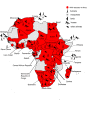Epidemiology of West Nile virus in Africa: An underestimated threat
- PMID: 35007285
- PMCID: PMC8789169
- DOI: 10.1371/journal.pntd.0010075
Epidemiology of West Nile virus in Africa: An underestimated threat
Abstract
Background: West Nile virus is a mosquito-borne flavivirus which has been posing continuous challenges to public health worldwide due to the identification of new lineages and clades and its ability to invade and establish in an increasing number of countries. Its current distribution, genetic variability, ecology, and epidemiological pattern in the African continent are only partially known despite the general consensus on the urgency to obtain such information for quantifying the actual disease burden in Africa other than to predict future threats at global scale.
Methodology and principal findings: References were searched in PubMed and Google Scholar electronic databases on January 21, 2020, using selected keywords, without language and date restriction. Additional manual searches of reference list were carried out. Further references have been later added accordingly to experts' opinion. We included 153 scientific papers published between 1940 and 2021. This review highlights: (i) the co-circulation of WNV-lineages 1, 2, and 8 in the African continent; (ii) the presence of diverse WNV competent vectors in Africa, mainly belonging to the Culex genus; (iii) the lack of vector competence studies for several other mosquito species found naturally infected with WNV in Africa; (iv) the need of more competence studies to be addressed on ticks; (iv) evidence of circulation of WNV among humans, animals and vectors in at least 28 Countries; (v) the lack of knowledge on the epidemiological situation of WNV for 19 Countries and (vii) the importance of carrying out specific serological surveys in order to avoid possible bias on WNV circulation in Africa.
Conclusions: This study provides the state of art on WNV investigation carried out in Africa, highlighting several knowledge gaps regarding i) the current WNV distribution and genetic diversity, ii) its ecology and transmission chains including the role of different arthropods and vertebrate species as competent reservoirs, and iii) the real disease burden for humans and animals. This review highlights the needs for further research and coordinated surveillance efforts on WNV in Africa.
Conflict of interest statement
The authors have declared that no competing interests exist.
Figures


References
-
- Smithburn KC, Hughes TP, Burke AW, Paul JH. A Neurotropic Virus Isolated from the Blood of a Native of Uganda. Am J Trop Med Hyg. 1940; s1-20(4): 471–92.
Publication types
MeSH terms
LinkOut - more resources
Full Text Sources
Medical

